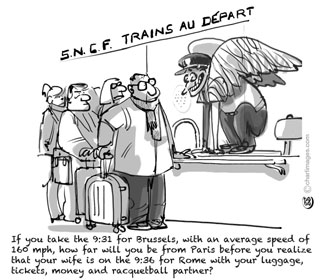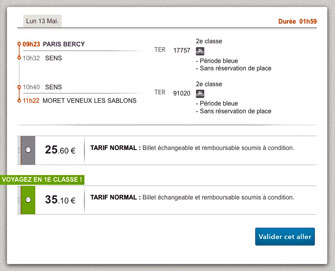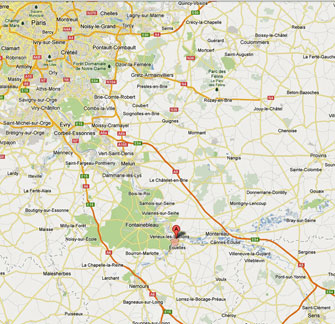
Generally speaking, France’s national railroad is great. The SNCF (Société Nationale des Chemins de Fer, or, in English, National Society of Carnival Shamans) offers clean, comfortable trains that cover virtually the entire country at high speeds, frequent intervals and affordable fares, making them the most convenient way to get almost anywhere. That is, if you can somehow manage to figure out where and when to take which divinely condemned, carnally knowledgeable train.
I say this because of what happened to Nancy and me on the weekend of May 8. For readers who can calculate calendars like Dustin Hoffman in Rain Man and wonder why the weekend started on Wednesday, the answer is quite simple: this is France.
As I explained in an article last year, the month of May is riddled with holidays here. This year, two of them fell on consecutive days, V-E Day on Wednesday, May 8 and Ascension Thursday on May 9, effectively rendering Friday, May 10 a national holiday as well — in compliance with the French Constitution (Article 1, Section 1: “Why bother?”), most offices just stayed closed until the following Monday.
During that five-day weekend, friends of ours who are spending their springtime cruising the rivers and canals of France invited us to join them on their boat, which was moored in Moret Sur Loing. We had been to Moret before and knew it to be a charming place, with interesting historical buildings and a lovely riverfront, so we eagerly accepted, and I got on the Internet to find out how I could wreck my sanity by transforming a simple weekend excursion into an epic exercise in frustration.
Or rather, that’s what I was actually doing. What I thought I was doing was getting on the Internet to find out how to get there by train.
Moret is only about 40 kilometers south of Paris, so I was unpleasantly surprised when I went to the SNCF Web site, asked for the schedule and got this:

It’s important to emphasize here that, according to the SNCF, this is the only way to get to Moret Sur Loing (or its sister town, Veneux les Sablons) from Paris. You can try this at home. There were a mere three trains per day, all with a change, all taking nearly two hours and all costing €25.60 per person per direction.
Oh, and all leaving from Bercy Station. It’s not at all important to emphasize anywhere, but I’m going to do it anyway: reflecting Paris’s Paricentric concept of the universe, the city has seven train stations scattered around town like used condoms on Rue Saint Denis, none connected to any of the others by main rail line.
In any case, I was prepared to shell out €102.40 for two round trips and spend two hours on the train either way, changing in someplace called Sens, wherever that was.
Unfortunately, as I was soon to realize, this information was a double boxcar-load of a substance that one expects to encounter on the streets of Pamplona but not in the timetables of a major transport company.
Fortunately, as I was soon to experience, a felicitous although Beckettesque sequence of events would lead me to that realization before I invested all that money and time.
The whole thing hinged upon an exceptional, and seemingly unimportant, detail: I had a discount coupon from a previous trip when our train had been late, giving us €20 off our next ticket purchase.
This complicated things. I usually book trains on the SNCF Web site, because the lines at the ticket windows in the Paris train stations are invariably long and slow-moving. Who needs the frustration?
The answer to that question was: me. To my surprise and frustration (hey – there’s that word again!), there was no way to use the coupon online. So we needed to get to Bercy early and queue up in order to talk to a living, breathing, coupon-redeeming ticket agent.
We arrived nearly an hour before departure time, and I took my place in line. Bercy is a small station with only six ticket windows. Apparently it also has a small staff, because four of those windows were closed, a fact that was not going unremarked by the dozen people ahead of me.
That figure soon dropped to six, not because the line had advanced but because half of the would-be passengers had given up in (guess what?) frustration. One of the open windows was occupied by a large multigenerational family and the ticket agent was taking forever calculating the various fares for the different age brackets, which ranged from infant in diapers to senior in an understandably impatient mood.
At the other window was a young woman standing silently and motionlessly in front of a ticket agent who was staring silently and motionlessly at his computer screen. Every few minutes, he would click something, murmur one or two syllables and resume staring. I have no idea what the problem was, but it was taking longer to resolve than the Eurozone sovereign debt crisis.
Seeing this and knowing that my own transaction was going to last less than a minute was, in a word, frustrating. Especially because I had noticed that another ticket agent was sitting at one of the closed windows, evidently about to open.
In keeping with the principle of learning something new every day, I learned something that morning: starting work as an SNCF ticket agent is a complex, multiphased, time-consuming process – I guess, because she was back there counting her change, scanning her badge, adjusting her chair, checking her cellphone messages, practicing her motionless stare, etc., etc., for the entire time I was in the queue.
So I did not live to witness her grand opening, but I eventually got my turn with one of her coworkers, who informed me (in less than a minute!) that tickets to Moret were only available at another station, the Gare de Lyon.
This filled me with a familiar sensation. It seemed hallucinatorily absurd that it was impossible to buy tickets at Bercy for a train leaving from Bercy, but since Gare de Lyon is only one Métro stop away, Nancy and I headed underground, wondering how we were going to make it back in time to catch our train.
Once in the other station I spotted an information booth with no line, so I went to check that I had indeed been correctly informed and not stepped through a wormhole into a parallel and even more frustrating than usual universe.
And there, for the second time in 20 minutes, I learned something: there are other trains — in fact many, many other trains — to Moret Sur Loing. Trains that leave from Gare de Lyon. That run every half hour. That take only 40 minutes to get there. And that cost only €7.50 per passenger. Like the photos of “lonely singles” in a pop-up ad, it seemed too good to be true.
When I asked the information lady why in the name of all things holy, and quite a few things blasphemous, the SNCF Web site fails to mention all this, she explained that “Moret is within the Greater Paris region, so it’s a completely different system.” And when I asked how I was supposed to be aware of that, she blithely replied, “Il faut savoir” (“You just have to know”), as though that clarified everything.
Overcoming, with effort, the desire to punch through the window and shake her like a paint can, I ended up buying much cheaper tickets for a much faster train, with no change in Sens. Speaking of which, take a look at this map:

That’s Paris in the upper left, Sens in the southeast corner and Moret in the middle marked with a Google Maps “A” because it’s too small to warrant mention at this scale.
So that’s why the original itinerary took so long: the intermediary station is twice as far from Paris as the final destination. In other words, changing in Sens doesn’t make any.
Anyway, having at last acquired both tickets and a new level of SNCF enlightenment, Nancy and I found the designated platform, where the train to Moret was standing in wait, with doors open, plenty of seats available, soothing music playing and misty white-clad figures beckoning to us from pools of light. But the frustration wasn’t over yet.
I then came up against yet another archetype of SNCF absurdity. As anyone who has ever taken a train in France knows, passengers are responsible for punching their own tickets. On every platform are little date-stamping machines with a slot for the insertion of tickets, surrounded by signs warning of a stiff fine for those who fail to pre-stamp.
That is to say, every platform except this one. I looked up and down the length of the remarkably long train, and all around that section of the station and saw no punching machines. It was like looking for a couples counselor on Rue Saint Denis.
After a few minutes I began to worry that I would miss the train entirely, leaving Nancy on it with all of the luggage and none of the tickets. So I went back to our car, muttering about the impossibility of complying with the rules and speculating upon where, with an SNCF agent’s cooperation, I would most like to insert my tickets.
But, to be a good citizen, I decided to wait by the door of the train in case a conductor came by. Which finally happened just before departure time. A man in uniform emerged from the next car and I stopped him to explain the situation. He told me that the puncher terminals were all downstairs, at the bottom of the underground access-ways to the platform. Once again, “Il faut savoir.”
The train was going to leave in about three minutes, so I asked if he couldn’t somehow validate the tickets for me. The answer was no – in other words, SNCF conductors get decent pay, excellent benefits, early retirement and spiffy uniforms, but their job can only be done by a machine.
Given no choice, I ran downstairs, finally found one of the well-hidden terminals and sprinted, panting, back up to the platform, where the pressure of my foot hitting the top step into the car (apparently) made the train take off.
And thus we arrived in Moret Sur Loing earlier, wiser and slightly wealthier, but only at the cost of much bafflement, flop sweat and (see above) frustration. It was a good thing we had that discount coupon, or I would have downloaded the expensive tickets and taken the roundabout route to Moret. I must have a guardian angel.
An SNCF guardian angel, obviously, because he takes forever to start working, spends a lot of time just staring motionlessly, and, for all the good he does, could just as well be replaced by a machine.
Reader Elaine Breakstone writes: “You are so incredibly on target. I have never in 35 – no, 55 – years of travel in France had what I would call a perfect rail journey start to finish. The ‘rules’ make no sense, the ticket validation machines are nowhere to be found, and if you are lucky enough to spot one, the machine is broken. Quel désastre!”
Reader Nick Roche writes: “Sorry to hear about your ordeal; however, I’ve taken the trains in France a number of times and have always had a great experience. The SNCF employees have been most helpful, but I have never taken it on the beginning of a holiday period when those working have to work the holiday – maybe that was your problem. ‘Mais il faut savoir!’”
Reader Katherine Albrecht writes: “What a pleasure to read David Jaggard’s most recent article about the French train system. ‘Il faut savoir’ – I can just hear them perfectly. AARRGGHH!!!”
Reader Richard Ewen writes: “This past April, my wife and I went to the Gare d’Lyon, and they had moved the ticket office for the banlieue (commuter trains within the Ile de France) tickets. After we found it and the proper line to stand in, we got on our train, but I forgot to punch the ticket at the head of the track. When the conductor came by, we asked that he please validate the ticket, and he kindly did do with a smile. I think the attitude of SNCF employees is generally good, but that of the ticket sellers is not – they spend all day behind those counters dealing with bewildered travelers.”
© 2013 Paris Update
FavoriteAn album of David Jaggard’s comic compositions is now available for streaming on Spotify and Apple Music, for purchase (whole or track by track) on iTunes and Amazon, and on every other music downloading service in the known universe, under the title “Totally Unrelated.”
Note to readers: David Jaggard’s e-book Quorum of One: Satire 1998-2011 is available from Amazon as well as iTunes, iBookstore, Nook, Reader Store, Kobo, Copia and many other distributors.
